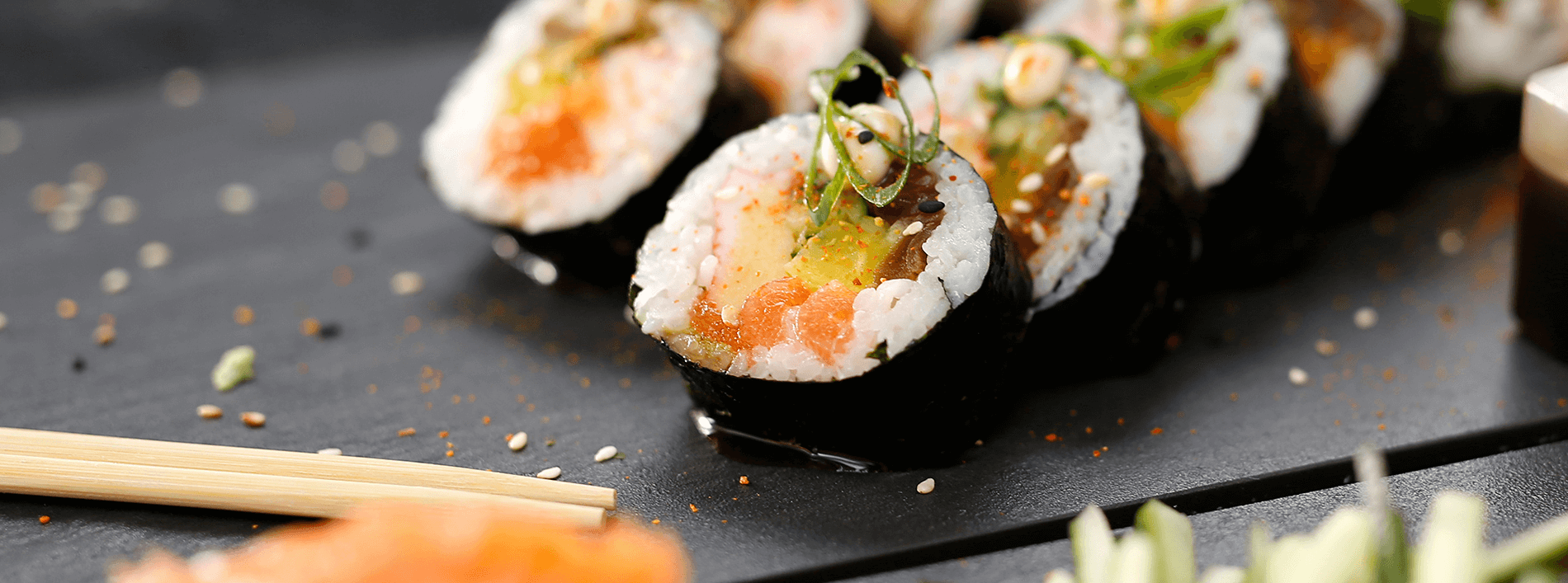Slicing fish and rolling rice can’t be that hard, you might think as you munch on a tasty piece of home delivery sushi. How tricky can making temaki really be? If you think that the work of an itamae (sushi chef) would be a walk in the fishy park, you’d be totally wrong. In fact, becoming a respected itamae takes precision, commitment and upwards of 10 years. So much for just slicing up some salmon…
What is an itamae?
The word itamae literally translates as “in front of the board” – in this case the chopping board on which sushi is prepared. An itamae isn’t just a sushi chef, he or she is a master craftsman, an artist, an artisan, a stern ruler of the kitchen, a true gourmet and a charming host.
Traditionally dressed in a white chefs’ hat, a white apron and a white coat, with their sushi knives (known as hocho) tucked into a sheath on their waist, the itamae cuts an impressive figure in the kitchen and commands respect, particularly in Japanese culture.
In Japan itamae are treated with true reverence and there are even tales about a great itamae, referred to respectfully as itamae-san, who could create nigirizushi with rice grains which all pointed the same way. Attaining this mythical standard is a long and devoted road.
Getting started
Every itamae worth his wasabi started in a sushi kitchen as an apprentice. While schools can teach sushi preparation, the only real way to become a respected itamae is to learn on the job from the very, very bottom, all the way up to the top.
Cleaning duty
That means that you’ll need to start on cleaning duty. Washing up, cleaning up, scrubbing up. In the first sushi kitchen you enter you will be the dogsbody. And don’t expect to get promoted any time soon. This part of your training is all about proving your devotion to becoming a truly fine itamae. Knuckle down, do your very best, make yourself as useful as possible and never, ever complain. Keep this up for a few months (or even a year) and you could be offered a very special task to complete…
Preparing the rice
The rice prepared in each sushi kitchen is a very closely guarded secret. It’s also every itamae’s pride and joy. The rice used to create beautiful sushi has to be perfect. The perfect consistency, the perfect flavour, the perfect colour. Every chef has their own secret recipe, which means that the opportunity to make the rice is a great honour and privilege.
The rice mix is prepared every day with rice, vinegar and salt. If you are asked to prepare the rice each day, you will do so under the close scrutiny of your itamae until they are satisfied that your work is absolutely perfect. Keep producing perfect rice day after day, continue making yourself as useful as meticulous in the sushi kitchen as possible and you may one day find yourself promoted to the level of wakiita…
Becoming a wakiita
Wakiita literally means “near the cutting board” in Japanese, which means that you’ve successfully climbed another rung of the sushi kitchen’s ladder and you’re one step closer to becoming a fully fledged itamae. But don’t get carried away just yet. Some wakiita can work beneath their itamae for years and years before becoming an itamae in their own right – there’s just so much to master.
A wakiita has a great many responsibilities in a sushi kitchen, and each one must be completed with absolute precision. The exact tasks you will be given as a wakaiita will vary depending on your itamae and their trust in you. To begin with you may be undertaking simple preparatory tasks such as grating ginger and preparing wasabi. Later on you may find yourself preparing fish, slicing scallions and even preparing sushi takeaway orders for your itamae. At the wakiita stage, however, an aspiring itamae will finally be allowed to wield their very own sushi knives, known in Japanese as hocho…
Mastering the hocho
Hocho come in a huge variety of shapes and sizes, all designed to precisely and perfectly slice sushi ingredients. Incredibly sharp and traditionally made from high quality carbon steel (the same material used to craft a samuari’s katana), hocho are items which command great respect.
Permission to use a hocho in a professional sushi kitchen is a clear sign that you have earned enough trust and respect from your itamae to take you all the way. Here are a few common hocho varieties you will need to familiarise yourself with.
• Tako hiki – Translates as the octopus puller, this knife has a rectangular end
• Yanagiba – Translates as the willow blade, this knife has a pointed end
• Fugu hiki – Translates as the pufferfish puller, this is a thin, flexible blade
• Oroshi hocho – This knife can measure up to 2 metres and is used to fillet large tuna
Becoming an itamae
After years of apprenticeship and training, followed by years as a wakaiita, you may finally be appointed as an itamae. Your training could take as long as 20 years, although this is not stereotypical. A realistic timeframe in which to achieve your itamae dreams is 10 years of complete concentration, dedication, devotion and mastery of this incredibly precise cuisine.
Becoming a truly great itamae
If you want to become a truly great itamae, there are four aspects you need to focus on:
• How you handle your ingredients
• How you handle your hocho
• How you interact with your clients
• How you work, move and behave
Exhibit precision, charm and elegance in each of these areas and you could become a true itamae-san, worthy of all the respect that the title entails. You’d better get training, then…!



